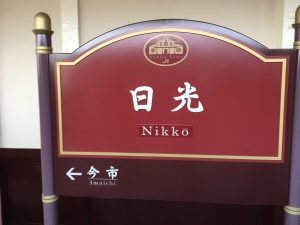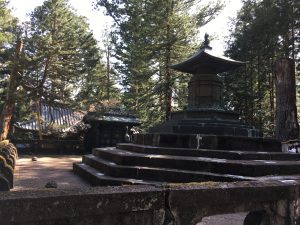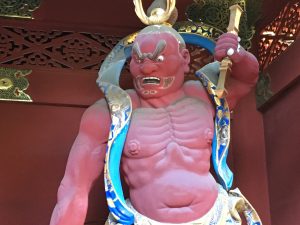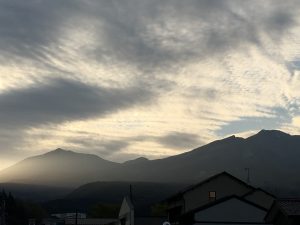Another road trip outside of Tokyo — north to Nikko. We took several trains to get there, and upon leaving the next to last station, all the workers lined up and waved goodbye to our train. Interesting sight.The mountainous region of Nikko is so enchanting that as long ago as the 8th C it attracted the attention of influential priests. Protected by Mount Nantei, Nikko is dotted with shrines and temples, and was regarded as a holy place rich in kami (divine beings in Shinto religion). The entire area is designated a UNESCO World Heritage Site. The first shogun built his mausoleum here — considered the most beautiful in Japan, and everyone goes to visit it. Apparently even more than everyone during Golden Week — it was jammed with people, and people carrying their dogs!
First stop was Shinkyo, The Sacred Bridge, which is a vermillion lacquered bridge over the River Daiyo.The legend of the bridge tells the story of a Buddhist monk who came to the area to teach Buddhism, but the rapid current of the river stopped him, so he asked for divine help. A god appeared on the other side of the river and threw two snakes that entwined themselves into a bridge so the monk could cross over. For 200Y you can have a paper airplane on which to write a wish and fly it over the bridge into the river, which of course I did.
The first temple that you come to after the bridge is now called Rinno-ji, the largest temple in Nikko. It is undergoing extensive renovation, so the only thing you can do is walk on an interior walkway and catch a glimpse of the Room with the Three Buddhas. The center one is called the Buddha of Infinite Light, and it is glanked by the Senju Kannon (goddess of thousand hands), and Bato Kannon (goddess with a horse’s head, protector of the animal kingdom and banisher of bad humor). It was unfortunate to not be able to see any of this temple.
Next up, Tosho-gu. This is the largest shrine in Nikko, and just past the impressive granite torii is a five story pagoda, which is as tall as the Tokyo Tower at 98 ft. The queue to buy a ticket to this shrine went way down the hill, past the gate and the pagoda and then up the next set of stone steps, and through a gate with figures sculpted throughout. On the left the stables with an illustration of the monkeys of “see no evil, hear no evil, speak no evil”, which supports the Tendai Buddhist tenet that if we don’t see, speak or hear evil we will be spared it in our lives. There are several buildings within the gate, each offering history and icons, but with the crowds, it was difficult to see or understand exactly where we were in the complex. The mausoleum is up a long set of steps, and you pass under the Namuri neko carved beneath the lintel on the way to the corridor and 200 steps. The Sleeping Cat is attributed to the sculptor Hidari Jungoro, with a small sparrow to one side, representing a desire for peace. The tomb itself is surrounded by lovely Japanese cedars.
Lastly, Taiyu-in, and our favorite. Maybe it was the lack of crowds by late in the afternoon, but this shrine was in a very peaceful spot down a long path from the previous one. The Nio-mon gate houses the two statues representing the sacred sound Om. The first sound we make, “ahhh”, with mouth open, is represented by Agyo, and the last sound we make, “mmm”, is shown as Ungyo, with his mouth closed. There are several gates to pass through and then a short walk around the hall of worship, where 140 dragons decorate the ceiling to get to the mausoleum of Shogun Iemitsu. With much regard for grandfather, he had it looking north instead of the traditional southwest, so he could face his ancestor even in death.
A long day of shrines and temples, and then a stroll back to the station with a beautiful view of the mountains as the sun set.





















